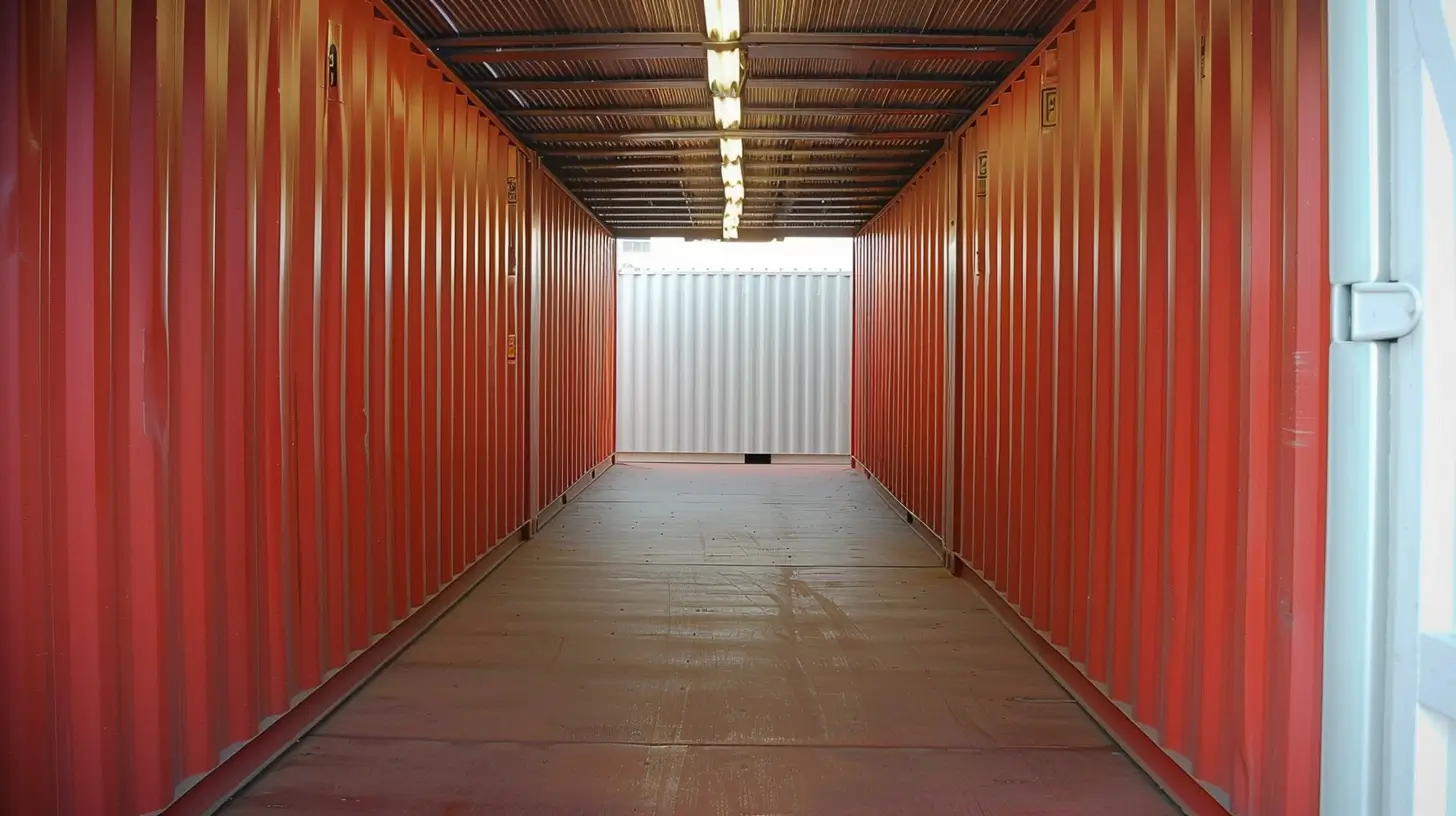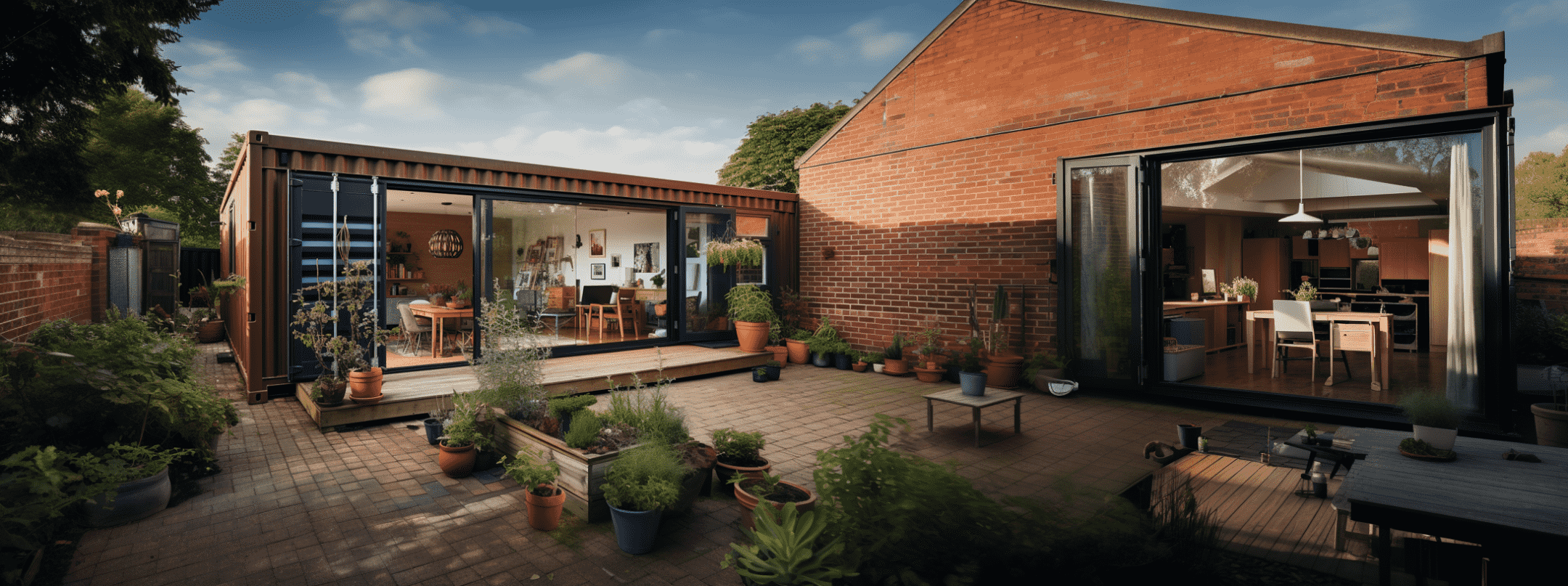Picture a shipping container. You’re probably focusing on the outside: strong steel walls, roof, and securely locked doors. But what’s inside is just as important.
The floor of the shipping container is one of the most important parts. It supports the cargo, protects from damp, and can change the entire look and feel of a container conversion.
With so many different types of shipping container floors to choose from, picking the right one can make a big difference. It not only helps keep the floor itself in great condition but also plays a big role in how long your container will last overall.
What are shipping container floors made from?
Shipping container floors have to be strong, long-lasting, and able to support weights of up to 30 tonnes — as well as forklifts moving cargo in and out.
Most shipping containers are made of corten steel, including cross-sheets underneath the floor to brace it with extra strength. Above the steel cross-sheets, there’s a layer or plywood, hardwood, steel or other material.
Marine-grade plywood is used in most shipping containers which are still in use for cargo. But if you’re using a converted shipping container as a guest house, office, or studio, then you could opt for a different type of flooring.
Plywood
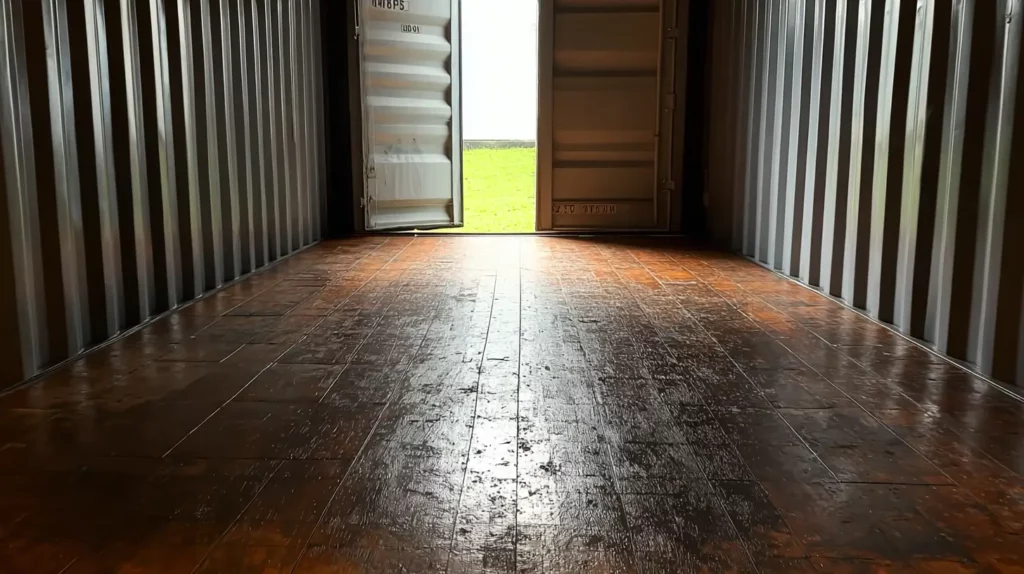
Plywood is the basic standard for shipping container flooring. Most containers use marine-grade, hardwood plywood, such as Apitong or Keruing. It comes in 25-30mm thicknesses. Some older containers may have timber planks instead.
H4 – Benefits and challenges of plywood
Plywood is a popular choice because it’s sturdy, temperature-resistant, and can cope with heavy loads. But it has one weakness: it can attract pests. Plywood container flooring has to be infused with insecticides and pesticides which can give off a strong smell when new.
Bamboo
Bamboo is a more eco-friendly alternative to plywood, since it comes from quick-growing forests instead of the old-growth hardwood forests needed for plywood. It’s also strong and durable.
Benefits and challenges of bamboo
Bamboo is more pest-resistant than traditional plywood. However, it’s vulnerable in other ways. It can be easily scratched, and has to be sealed with epoxy to protect it from water damage. Bamboo container flooring is often more expensive than other options.
Steel and aluminium
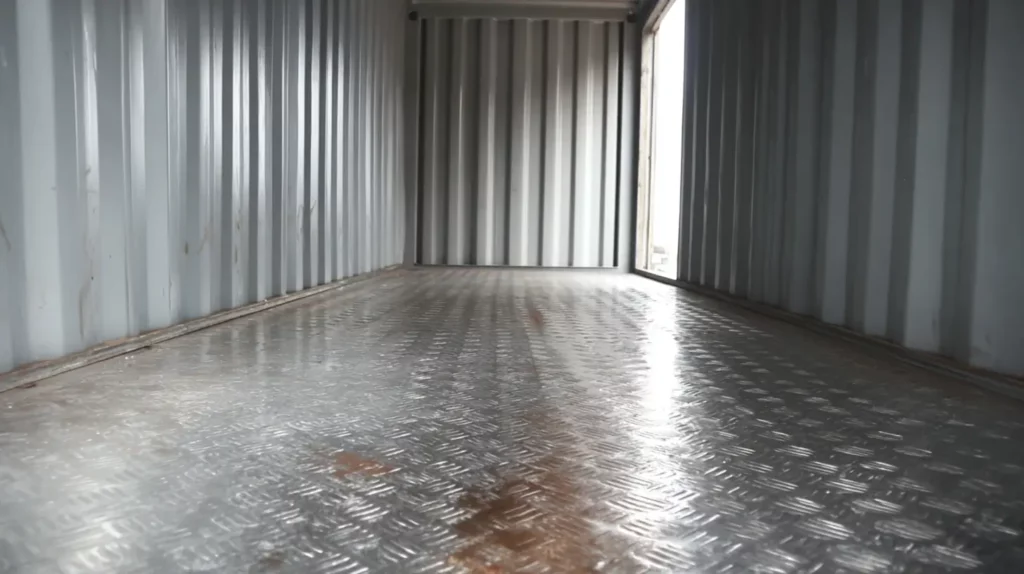
You’ll often find steel or aluminium flooring in refrigerated or insulated containers, because they help maintain a consistent internal temperature. The most common steel flooring types are smooth plates or grippy tread steel. Both are watertight and easy to clean after use.
Benefits and challenges of steel and aluminium
Metal flooring is extremely easy to maintain and clean. It doesn’t hold odours, attract pests, or scratch easily. Steel and aluminium can also be recycled, which makes them a greener choice than traditional plywood. However, they’re on the higher end of flooring price ranges.
Imitation wood and vinyl
Vinyl and imitation wood have already become popular flooring choices for home decor. Now they’re often used as flooring in container conversions for home offices and holiday homes.
Benefits and challenges of imitation wood and vinyl
Vinyl is cheap, durable, and water-resistant. They’re a low-effort option, since vinyl planks can be installed directly over the original shipping container flooring. The vinyl planks snap together for installation, which means it’s easy to lay the floor and then swap out any damaged planks over time.
However, some people dislike the look of vinyl — and there’s some evidence that some vinyl products can be bad for indoor air quality.
Coin vinyl
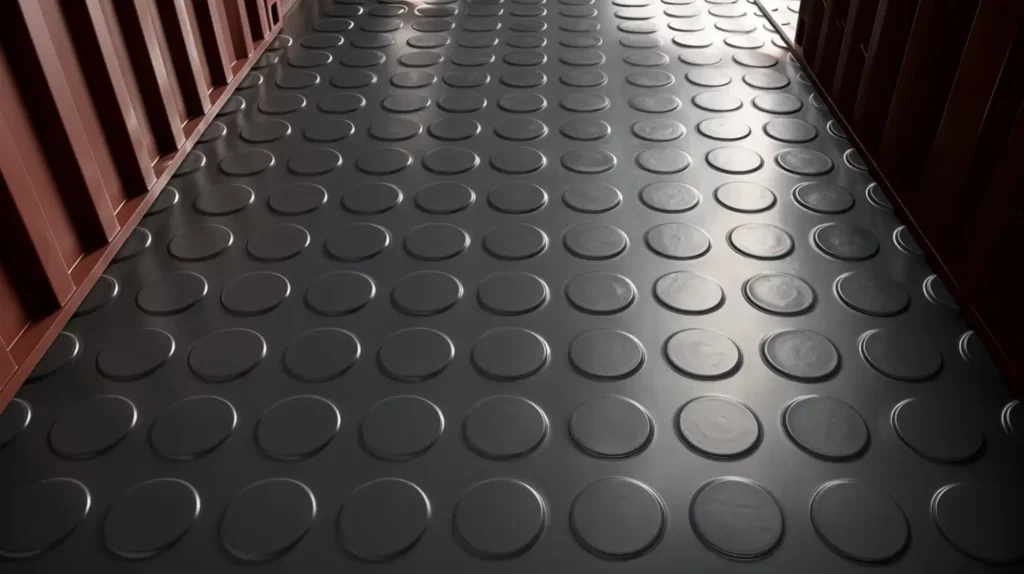
Coin vinyl, also known as coin rubber flooring, is good for container conversions which get a lot of foot traffic or where you need extra grip. If you’re using a container as a bathroom, greenhouse, or to transport liquids, it might be the best choice for you. Just like vinyl planks, coin vinyl can be installed over the original shipping container flooring.
Benefits and challenges of coin vinyl
Coin rubber flooring is waterproof, slip-resistant, and easy to mop clean. It’s also durable and easy to install. However, it usually comes in a limited range of colours, and may fade in bright light over time.
Epoxy coatings
Epoxy coating is made from a mix of resin and hardener. You can coat it over wooden flooring to make it more durable and easy to clean. If you’re converting a container, but want to keep the original, industrial look of a plywood or bamboo floor, then epoxy coating is an ideal sealant.
Benefits and challenges of epoxy coatings
Epoxy coating protects wooden flooring and seals in pesticides, meaning that it’s safe to use in container conversions. The coating is also waterproof, scratch-proof, and slip-resistant. However, epoxy does have its own issues. You’ll need a professional install to make sure that the surface is prepared and the epoxy is cured correctly. Epoxy coatings can also degrade in bright sunlight or fluctuating temperatures.
Commercial carpet tiles
You’ll recognize commercial carpet tiles from offices and classrooms: large, square or rectangular tiles of carpet that are designed for hard wear. The main benefit of commercial carpet tiles is that they’re easy to install and replace. If necessary, you can swap out individual tiles if they become stained or damaged.
Benefits and challenges of commercial carpet tiles
Carpet tiles are cost-effective, durable, and slip-resistant. There’s usually a wide range of colours, shapes, sizes and styles available. Just bear in mind that carpet may wear unevenly depending on which areas get the most foot traffic. Carpet tiles are also vulnerable to mold if the container gets wet inside.
What else is beneath the surface of a shipping container?
Beyond the flooring, there’s much more to shipping containers than meets the eye. Each element plays a role in its strength, weather resistance, and functionality.
Discover what shipping containers are made of in our in-depth guide.
Read guideHow to choose a shipping container floor
The wide range of shipping container flooring types means there’s something for every use, style, and budget. When it comes to choosing a shipping container floor, there are a few key things to consider – like cost, durability, and how you plan to use the container.
Different flooring types offer different benefits, so it’s important to think about what matters most for your setup. Taking the time to choose the right floor can help you get the best value and performance from your container.
Durability
Shipping containers are designed to last under harsh conditions – and that includes the floor. If you’re using a container for shipping, storage, or a workshop with heavy-duty machinery, then durability matters. Plywood, steel, or aluminium is likely to work best.
Cost
Cost is a key consideration in almost every container conversion project. Plywood is one of the most budget-friendly options, while vinyl or epoxy coatings can give you a more finished, home-like feel without breaking the bank.
Aesthetics
If you’re planning a container conversion, chances are you have a final look in mind: cosy, clean, industrial, or eco-friendly. Vinyl and imitation wood make for attractive finishes, but even humble plywood can look beautiful with a layer of varnish or wood stain.
Water resistance and maintenance
Water resistance is important if you plan to use a container for shipping, storage, or as a garage or crafting space. Vinyl and epoxy are both highly water-resistant. Steel and aluminum have a more industrial look, but they’re also easy to maintain and keep clean.
Intended use
As we’ve already mentioned, the intended use of the container makes a big difference to which flooring you choose. Containers which carry heavy loads or get a lot of foot traffic will need tough flooring like steel, aluminium, or thick vinyl. Similarly, if you have a shipping container business idea such as farming or a workshop, you might need durable and waterproof flooring. Holiday homes and home offices can get away with less durable flooring.
Pesticide treatment
Older shipping container floors have sometimes been treated with pesticides that can be harmful to humans. Look out for old plywood or bamboo which has a strong smell. If you’re concerned, you could replace the existing floor, or use an epoxy coating to seal in the pesticides.
Sustainability
Many people choose shipping container conversions because they’re an environmentally friendly option. To keep your carbon footprint low, choose sustainably sourced bamboo flooring or recyclable steel for the container’s floor.
Climate
The climate where you live will make a big difference to the flooring you need. Because shipping containers are made of steel, they can be affected by temperature changes and humidity, and you don’t want to risk mould or damp getting into the floor.
In hot climates, look for flooring options which are UV-resistant and won’t change size in hotter temperatures. Vinyl or solid hardwood is usually best. In cold, damp areas, you’ll need a floor which is water-resistant and freeze-resistant, such as vinyl or sealed plywood. Aluminium and steel are best if you want to keep the temperature inside the container low.
Want to stop condensation in your container before it starts?
Keep your container dry and damage-free with our damp sticks.
Buy damp sticksHow to maintain a shipping container floor
Just like the rest of the container’s maintenance, maintaining the floor involves regular inspection or cleaning. You should spot any rust, damp, or dents early on and fix them right away. You’ll also need proper ventilation in the container to prevent moisture build-up.
If the floor has been treated or coated, it will last much longer. Epoxy, polyurethane, acrylic, and bitumen coatings are all standard protective treatments. You could also look into anti-slip, fire retardant, or pressure treatments.
The bottom line
Shipping containers can use a range of flooring types. While plywood, bamboo, and steel are most common for cargo containers, you can also enhance container conversions with vinyl, carpet tiles, coin rubber, or epoxy coatings.
Which type of container flooring you choose will depend on factors such as the intended use, budget, and local climate. But whatever you choose, the container floor will need regular inspection and maintenance to keep it in good shape.
FAQs
Can I keep the floor that comes with the container?
Yes, you can usually keep the floor that comes with the container, especially if it’s in good condition and suits your intended use. Most shipping containers come with marine-grade plywood floors, but it could also be bamboo, steel, or aluminium.
Whether you replace the floor depends on your budget and how you plan to use the container. Marine-grade plywood or bamboo may have been treated with chemicals, so you might need to seal the floor with epoxy to reduce the risk of fumes.
How can I check a container floor for chemicals?
To tell if the container floor has been treated with pesticides or insecticides, check the front door. There will be a CSC plate on the door which includes a “timber component treatment” section. This will list the chemical used, its purpose, and when it was last treated. However, bear in mind that the CSC plate could be out of date if the shipping container has already gone through recent maintenance or modifications.
You can check this information against WHO safety guidelines to see if you need to replace or seal the floor.
How strong is a shipping container floor?
Shipping container floors are designed to be exceptionally strong and durable. Typically constructed from 28mm marine-grade plywood over steel cross members, they’re built to handle heavy, evenly distributed loads, often up to 25–30 tonnes. So whether you’re storing equipment, machinery, or converting your container for another purpose, the standard floor that comes with the container offers reliable support.
Looking for a completely custom solution?
We have a wide range of base containers that can be customised to your needs, however we
realise
that
sometimes you need something completely ‘Outside the box’.
Contact us and one of our experts will be in touch to help design the container of your
dreams


